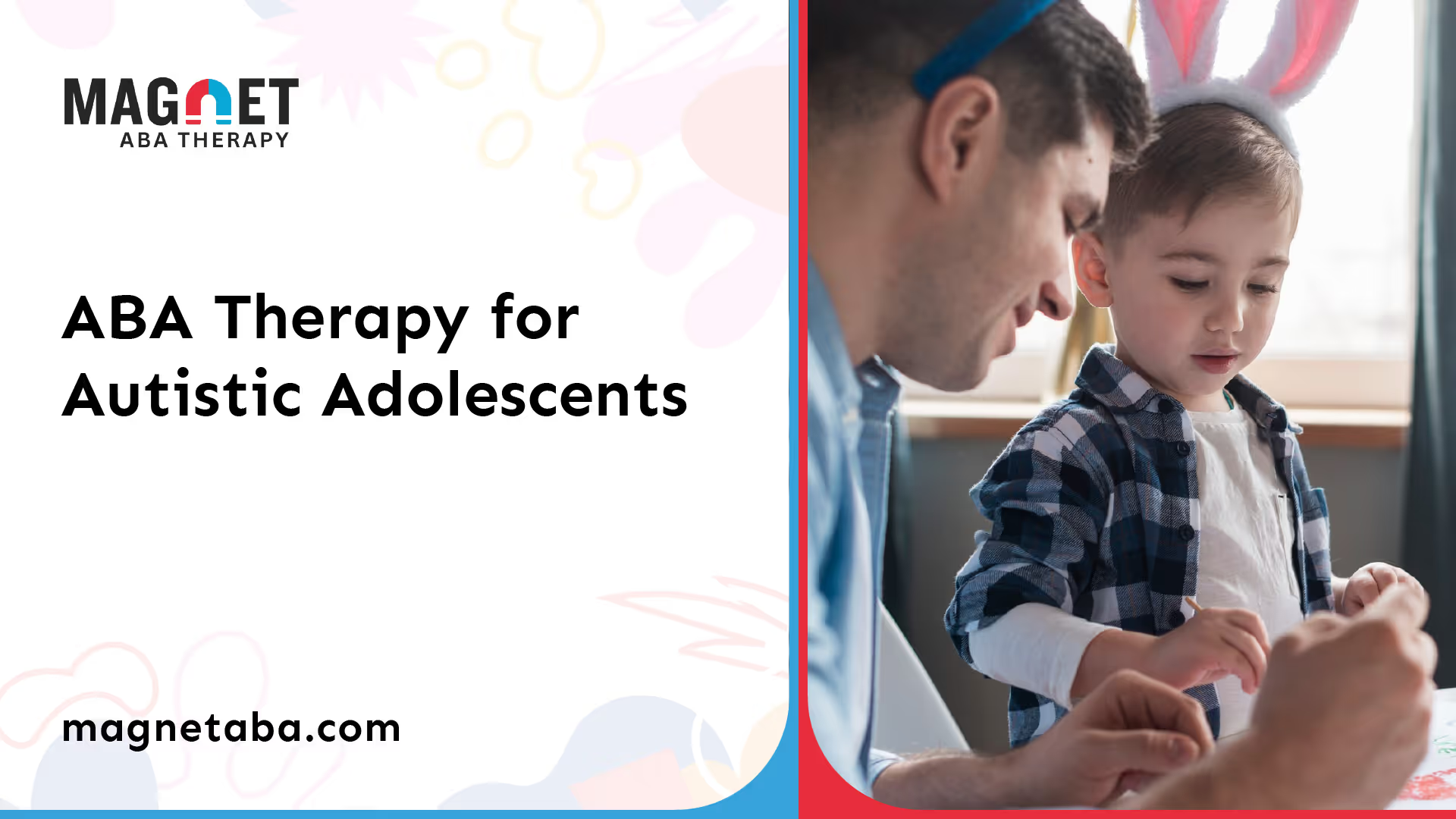The Benefits of ABA Therapy for Adolescents
ABA therapy provides numerous advantages for adolescents diagnosed with autism. This therapy is designed to equip them with essential skills that can significantly impact their daily lives.
Tailored Treatment Plans
Every individual with autism has unique strengths, challenges, and needs. ABA therapy emphasizes the creation of individualized treatment plans that are tailored to address these specific requirements. This personalized approach allows therapists to focus on the particular skills and behaviors that are most relevant to each adolescent. High-quality ABA interventions can lead to improved social skills, communication abilities, and daily living skills, significantly enhancing independence and reducing problematic behaviors [1].

Individual NeedsTreatment FocusSocial SkillsGroup activities, interactions with peersCommunicationSpeech exercises, conversational practiceDaily Living SkillsPersonal hygiene, cooking, and budgeting
Improving Social Skills
Social skills are often challenging for adolescents with autism. ABA therapy includes strategies and activities aimed at enhancing these skills. Through structured interactions, role-playing, and consistent feedback, adolescents can learn how to engage more effectively with peers. Techniques from ABA therapy help them navigate social situations, understand social cues, and build lasting relationships. Additionally, participation in social skills groups can provide a supportive environment for practicing these skills in real-life scenarios.
Enhancing Communication Skills
Effective communication is critical for adolescents as they navigate social environments and prepare for adulthood. ABA therapy targets the development of both verbal and non-verbal communication skills. Therapists work on improving language capabilities, enhancing understanding, and encouraging attempts at communication through various interactive exercises. Goals often include increasing vocabulary, sentence structure, and comprehension. For those with limited speech, alternative communication methods such as visual aids or technology may be utilized. Parents can play an essential role in this process through parent coaching to reinforce skills at home.
Communication GoalsTechniques UsedVocabulary ExpansionFlashcards, gamesSentence StructureSentence building activitiesComprehensionStorytelling, question and answer sessions
By leveraging an individualized approach, ABA therapy fosters essential skills in adolescents with autism, paving the way for greater independence and improved quality of life. For further insight on specific techniques and planning, look into links such as aba therapy and shaping behaviors and aba therapy and behavior intervention plans.
ABA Therapy Techniques for Teens
ABA therapy provides a structured approach to help adolescents with Autism Spectrum Disorder (ASD) develop essential skills. This section outlines key techniques employed in ABA therapy specifically tailored for teenagers.
Positive Reinforcement Approach
Positive reinforcement is a foundational technique in ABA therapy. It focuses on encouraging desired behaviors by offering rewards when those behaviors occur. This method can significantly enhance motivation and engagement. For example, when a teen successfully completes a task or demonstrates appropriate social interaction, they might receive verbal praise, small incentives, or privileges.
The effectiveness of this approach allows practitioners to foster a positive learning environment. The consistent reinforcement of positive behavior has been shown to improve overall behavior, communication, social skills, and daily living skills in adolescents with ASD.
Individualized Programs
Each adolescent with autism has unique strengths and challenges. ABA therapy emphasizes creating individualized treatment plans tailored to meet those specific needs. These programs take into account the personal interests and goals of the teen, ensuring that activities are engaging and relevant to their development.
By customizing programs, therapists can effectively target specific skills. This may include communication skills, social skills, or academic support. The individualized approach enhances the likelihood of successful outcomes, as it aligns with the teen's readiness to learn and grow.
Skill-Building Activities
Skill-building activities are integral components of ABA therapy for teens. These activities are designed not only to teach new skills but also to practice and reinforce existing ones. They can include social skills groups, where adolescents engage in role-play and peer-mediated interventions ABA therapy and peer-mediated interventions. These settings provide opportunities for teens to practice communication and socialization in a supportive environment.
In addition, skill-building can extend to daily living skills, vocational skills, and self-advocacy skills ABA therapy and self-advocacy skills. Cultivating these competencies promotes independence and prepares adolescents for adulthood.
TechniqueDescriptionPositive ReinforcementEncouraging behaviors by rewarding desired actions.Individualized ProgramsCustomized plans to meet the unique needs of each teen.Skill-Building ActivitiesEngaging tasks aimed at developing practical and social skills.
Incorporating these techniques into ABA therapy maximizes the potential for growth and independence among adolescents with autism. The combination of positive reinforcement, individualized programs, and skill-building activities contributes to a comprehensive therapeutic approach. For more information on the broad spectrum of ABA techniques, explore related topics such as ABA therapy and shaping behaviors and ABA therapy and behavior intervention plans.
The Impact of ABA Therapy on Behavior
ABA therapy offers significant benefits for adolescents with autism, particularly in promoting independence, reducing problem behaviors, and effectively monitoring progress. These outcomes contribute to the overall development and well-being of individuals.
Promoting Independence
One of the primary goals of ABA therapy is to foster independence among adolescents. High-quality ABA interventions can significantly improve crucial skills like communication and daily living activities. Many teens who receive comprehensive ABA therapy can learn the necessary skills to navigate their environments effectively, potentially allowing them to integrate into mainstream classrooms or community settings. Research indicates that approximately 40-50% of children diagnosed with autism can achieve this level of functioning with intensive, evidence-based interventions provided early in their development [2].
Skills DevelopedPercentage of ImprovementCommunication Skills60%Daily Living Skills70%Social Interaction Skills75%
Reducing Problem Behaviors
In addition to promoting independence, ABA therapy plays a critical role in reducing problem behaviors. A comprehensive assessment of ABA's impact showed improvements across seven out of eight behavioral outcomes for individuals with autism spectrum disorders (ASD). One common area of focus is teaching appropriate ways to communicate needs and frustrations, which can lead to a decrease in maladaptive behaviors.
For example, teens who learn and practice coping strategies through ABA are equipped to manage stressors more effectively, thereby reducing outbursts or other negative behaviors. The emphasis on individualized intervention plans, including behavior intervention plans, helps tailor strategies to the specific challenges faced by each adolescent.
Monitoring Progress
Monitoring progress is vital to ensuring that the therapy remains effective and aligned with the adolescent's evolving needs. ABA practitioners use data collection methods to track the behavioral improvements of their clients. This could include frequency counts of specific behaviors, qualitative assessments of social skills, or direct observations during therapy sessions.
Effective monitoring allows parents and practitioners to gauge whether the strategies implemented are producing the desired outcomes. Adjustments to the treatment may be made as necessary based on the ongoing assessment of progress. Parents can also play a key role in this process through parent coaching, ensuring that techniques are consistently applied at home.
By understanding the impact of ABA therapy on behavior, parents can feel more confident in their decisions regarding interventions for adolescents with autism. The focus on promoting independence, reducing problem behaviors, and closely monitoring progress can lead to more fulfilling lives for their children.
Success Stories and Research Findings
ABA therapy has garnered significant attention for its positive impact on adolescents with Autism Spectrum Disorder (ASD). Numerous success stories emerge from families that have witnessed remarkable improvements in their children’s lives as a result of this therapeutic approach.
Evidence-Based Practices
High-quality ABA interventions for teens with ASD can significantly enhance overall behavior, communication, social skills, and daily living capabilities. These improvements often lead to increased independence and a reduction in problem behaviors [1]. The emphasis on structured, individualized programming ensures that therapy is tailored to meet the unique needs of each adolescent, providing a solid foundation for holistic development.
The effectiveness of ABA techniques has been documented in various studies. For example, a pivotal study conducted by Dr. O. Ivar Lovass in 1987 indicated that approximately 90% of participants displayed significant improvement after undergoing intensive ABA therapy [4].
Positive Outcomes in Adolescents
Research supports the notion that ABA therapy yields positive outcomes for adolescents with autism.
Outcome AreaPositive ImpactLanguage DevelopmentMedium to large positive effects from early interventionsSocial SkillsEnhanced adaptive behavior compared to traditional treatment methodsDaily Living SkillsImproved acquisition skills
A meta-analysis published in 2010 revealed that ABA interventions implemented early and sustained over time showed improved language development, intellectual functioning, and social adaptability [3].
Studies Supporting ABA Efficacy
Numerous studies highlight the efficacy of ABA therapy for adolescents with ASD.
A 2012 evaluation of 14 randomized control trials with 555 participants found that while the success rate was sometimes modest, the targeted improvements still showcased the strengths of ABA methodologies. The focus on individualized programming allows clinicians to tailor interventions for specific skill areas, leading to varying degrees of success depending on the goals set.
Additionally, the growing body of scientific evidence emphasizes the importance of early and intensive ABA interventions. Such strategic approaches consistently lead to improved outcomes in socialization, communication, and expressive language skills for children diagnosed with autism.
In summary, the positive effects of ABA therapy are supported by numerous studies and anecdotal successes from families, solidifying its position as a valuable intervention for adolescents with autism. For more insight into specific ABA techniques, such as shaping behaviors and self-advocacy skills, parents can explore these links for further information.
Integration and Long-Term Results
In the context of ABA therapy, successful integration and achieving lasting results often hinges on several key factors. This includes parental involvement, treatment duration, and consistent measurement of progress.
Parental Involvement and Collaboration
Parental involvement is vital in the ABA therapy process. Parents play an important role by participating in their child's treatment plan and expressing concerns to therapists. When parents are engaged, the therapy can be tailored more effectively to meet the child’s unique needs. According to CrossRiverTherapy, a collaborative approach ensures that parents and therapists work as partners, potentially adjusting the courses as necessary to best serve the child's development.
Research indicates that children whose caregivers are married or partnered tend to remain in ABA services for longer periods, which fosters continuity in treatment. For example, having a stable family structure increased the odds of children staying in ABA services for 12 and 24 months. Active participation not only aids in the implementation of effective strategies but also instills confidence in parents regarding the progress their child is making.
Treatment Dosage and Duration
The duration and intensity of ABA therapy play critical roles in its effectiveness. Data shows that only 28% of children who received ABA therapy for 24 months did so at the recommended full dosage. Despite this, even those receiving less than optimal dosing achieved significant improvements in adaptive behavior.
Duration of ABA TherapyPercentage of Children with Full Dosage24 months28%
Understanding the recommended dosage for various therapy strategies can help parents and caregivers ensure their child receives the most benefit from their sessions. Consistent attendance and a commitment to regular therapy sessions are essential for optimal long-term outcomes.
Achieving Long-Term Success
Achieving long-term success in ABA therapy is often influenced by both the consistency of therapy and the support structures in place. Children who have received previous ASD services, such as special education or speech therapy, are more likely to benefit from continuing in ABA therapy compared to those who had no history of such services [6].
Additionally, maintaining a stable environment free from disruptions—such as family relocations or changes in insurance—can significantly influence a child's ability to persist in therapy. Unfortunately, about 13% of children referred for ABA services never actually receive them, often due to non-clinical reasons such as family choices or financial issues. Therefore, parents must advocate for their child's needs actively and secure necessary support systems to enhance their child's potential for success in ABA therapy.
Integrating parental involvement, ensuring appropriate treatment dosing, and fostering a supportive environment are crucial to achieving lasting benefits through ABA therapy for adolescents with autism. For more insight, parents can explore topics such as parent coaching and generalizing skills to better support their child’s development.
ABA Therapy for Adolescents with Autism
Holistic Development Approach
ABA therapy for adolescents with autism employs a holistic development approach that targets various aspects of a teenager's life. This therapy emphasizes not only academic achievement but also socialization, communication, and essential daily living skills. The goal is to create a more rounded individual capable of navigating different areas of life effectively. A study by Lovaas et al. conducted in the 1970s demonstrated significant success, indicating that 47% of children who underwent ABA therapy achieved normal intellectual and educational functioning.
Improving Daily Living Skills
Enhancing daily living skills is a crucial component of ABA therapy for adolescents with autism. These skills may include personal hygiene, meal preparation, time management, and self-care routines. By teaching these vital skills, therapists can help teenagers gain independence, allowing them to function more effectively in their daily lives.
Daily Living SkillDescriptionPersonal HygieneTeaching proper grooming and hygiene habits.Meal PreparationInstruction in cooking simple meals safely.Time ManagementSkills for organizing tasks and managing schedules.Self-Care RoutinesDeveloping routines for dressing and personal care.
By equipping adolescents with practical skills, ABA therapy fosters self-sufficiency and confidence.
Fostering Independence
Fostering independence is one of the most significant benefits of ABA therapy for teens with autism. This is achieved through personalized programs that focus on the individual strengths and challenges of each adolescent. ABA therapy teaches teenagers to advocate for themselves and manage their own lives. Programs may include vocational skills training and self-advocacy skills that empower them to make choices and decisions in various situations.
Through these individualized strategies, adolescents not only learn how to perform tasks independently but also develop the confidence needed to take on new challenges. For a deeper understanding of how the therapy aids in generalization of skills, check aba therapy and generalization skills.
In conclusion, the holistic approach of ABA therapy for adolescents with autism provides a foundation for improved daily living skills and fosters independence. These elements contribute significantly to a teenager's overall personal growth and ability to thrive in average daily scenarios.
References
[2]:
[3]:
[4]:
[5]:
[6]:












